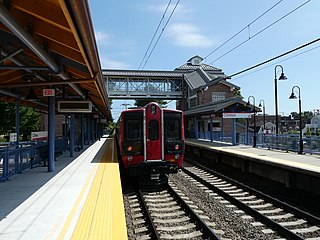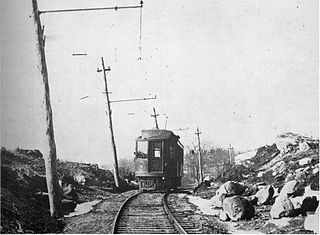
The interurban is a type of electric railway, with tram-like electric self-propelled railcars which run within and between cities or towns. The term "interurban" is usually used in North America, with other terms used outside it. They were very prevalent in many parts of the world before the Second World War and were used primarily for passenger travel between cities and their surrounding suburban and rural communities. Interurban as a term encompassed the companies, their infrastructure, their cars that ran on the rails, and their service. In the United States, the early 1900s interurban was a valuable economic institution, when most roads between towns, many town streets were unpaved, and transportation and haulage was by horse-drawn carriages and carts.

Shore Line East (SLE) is a commuter rail service which operates along the Northeast Corridor through southern Connecticut, United States. The rail service is a fully owned subsidiary of the Connecticut Department of Transportation (CTDOT) and is operated under the CT Rail brand. SLE provides service seven days a week along the Northeast Corridor between New London and New Haven; limited through service west of New Haven to Bridgeport and Stamford has been suspended since 2020. Cross-platform transfers to Metro-North Railroad New Haven Line trains are available at New Haven for service to southwestern Connecticut and New York City. Pre-COVID, around 2,200 riders used the service on weekdays.

Southern New England at one time had a large network of street railway lines, including several true interurban streetcars. It was possible to go from New York City to Boston completely on streetcars on at least three routes: via Hartford, Connecticut, Springfield, Massachusetts, and Worcester, Massachusetts; via New London, Connecticut and Worcester, or via New London and Providence, Rhode Island.

The Shore Line Railway was a part of the New York, New Haven and Hartford Railroad system, running east from New Haven, Connecticut, to New London along the north shore of Long Island Sound. A segment is currently used for commuter service on CT Rail's Shore Line East and regional/express service on Amtrak's high-speed Northeast Corridor.

The Shore Line Trolley Museum is a trolley museum located in East Haven, Connecticut. Incorporated in 1945, it is the oldest continuously operating trolley museum in the United States. The museum includes exhibits on trolley history in the visitors' center and offers rides on restored trolleys along its 1.5 mi (2.4 km) track as the Branford Electric Railway. In addition to trolleys, the museum also operates restored subway cars, a small number of both trolleybuses and conventional buses.

The Sacramento Northern Railway was a 183-mile (295 km) electric interurban railway that connected Chico in northern California with Oakland via the state capital, Sacramento. In its operation it ran directly on the streets of Oakland, Sacramento, Yuba City, Chico, and Woodland. This involved multiple car trains making sharp turns at street corners and obeying traffic signals. Once in open country, SN's passenger trains ran at fairly fast speeds. With its shorter route and lower fares, the SN provided strong competition to the Southern Pacific and Western Pacific Railroad for passenger business and freight business between those two cities. North of Sacramento, both passenger and freight business was less due to the small town agricultural nature of the region and due to competition from the paralleling Southern Pacific Railroad.
Coastal Connecticut, often called the Connecticut Shore or the Connecticut Shoreline, comprises all of Connecticut's southern border along Long Island Sound, from Greenwich in the west to Stonington in the east, as well as the tidal portions of the Housatonic River, Quinnipiac River, Connecticut River, and Thames River. It includes the southern sections of the state's Fairfield, New Haven, Middlesex and New London counties.

The Third Avenue Railway System (TARS), founded 1852, was a streetcar system serving the New York City boroughs of Manhattan and the Bronx along with lower Westchester County. For a brief period of time, TARS also operated the Steinway Lines in Long Island City.

The Connecticut Company was the primary electric street railway company in the U.S. state of Connecticut, operating both city and rural trolleys and freight service. It was controlled by the New York, New Haven and Hartford Railroad, which also controlled most steam railroads in the state. After 1936, when one of its major leases was dissolved, it continued operating streetcars and, increasingly, buses in certain Connecticut cities until 1976, when its assets were purchased by the state government.

Old Saybrook station is a regional rail station in Old Saybrook, Connecticut. It is served by both Amtrak Northeast Regional intercity trains and CT Rail Shore Line East commuter service.

New London Union Station is a railroad station on the Northeast Corridor located in downtown New London, Connecticut, United States. Union Station is a station stop for most Amtrak Northeast Regional trains and all CT Rail Shore Line East commuter rail trains, making it the primary railroad station in southeastern Connecticut. It serves as the centerpiece of the Regional Intermodal Transit Center, with connections to local and intercity buses as well as ferries to Long Island and Fishers Island, New York, and Block Island, Rhode Island. The station has one side platform and one island platform serving the two-track Northeast Corridor; the latter platform also serves a siding track that connects to the New England Central Railroad mainline.

Clinton station is a regional rail station served by the CT Rail Shore Line East service located near downtown Clinton, Connecticut. The station has two side platforms connected by a footbridge. Clinton is a commuter-only station; Amtrak's Acela and Northeast Regional services run through the station without stopping.

The Norwich and Westerly Railway was an interurban trolley system that operated in Southeastern Connecticut during the early part of the 20th century. It operated a 21-mile line through rural territory in Norwich, Preston, Ledyard, North Stonington, and Pawcatuck, Connecticut to Westerly, Rhode Island between 1906 and 1922. For most of its length, the route paralleled what is now Connecticut Route 2.
The Clamdigger was a daily passenger train which ran along the Northeast Corridor during the 1970s. The train had two iterations: from 1898 to 1972 it was a local commuter service under the New Haven Railroad, Penn Central, and Amtrak between New London and New Haven, while from 1976 to 1978 it was a long-distance commuter service operated by Amtrak from Providence to New Haven. In 1978, it was canceled and replaced with the Beacon Hill.
The Manhattan and Queens Traction Company, also known as the Manhattan and Queens Transit Company, was a streetcar company operating in Manhattan and Queens County, New York between 1913 and 1937.

The New London and East Lyme Street Railway was a streetcar line that operated in southeastern Connecticut. Its main line ran from New London to Niantic with a later extension to Crescent Beach and a branch to Old Saybrook.

The New York and Stamford Railway was a streetcar line that connected the Westchester County suburbs of New Rochelle, Larchmont, Mamaroneck, Harrison, Rye, and Port Chester, with the Connecticut suburbs of Greenwich and Stamford. The company was formed in 1901 when the New York, New Haven and Hartford Railroad combined the Larchmont Horse Railway Company with the Port Chester Street Railroad Company. The Larchmont Horse Railway Company was founded in 1888 by the Larchmont Manor Company to construct a line from the New York, New Haven and Hartford Railroad Larchmont train station to its development 1.2 miles from town. The line was rebuilt for electric operation and extended to Harrison in 1901. The Port Chester Street Railroad opened in 1898 serving Port Chester, New York. The trolley line was soon extended west through Rye to Harrison in 1901. The two companies were merged that summer to form the New York and Stamford Railway. Trackage rights over the Westchester Electric Railroad were obtained for access to New Rochelle.
The Danbury and Harlem Traction Company was an unfinished electric rapid-transit interurban railroad connecting Danbury, Connecticut, with the New York Central Railroad station at Goldens Bridge, New York, on the Harlem Line.

Niantic was a train station on the Northeast Corridor located in the Niantic village of East Lyme, Connecticut. Opened in the 1850s, it was rebuilt in 1899 and again in 1954 by the New Haven Railroad. It closed in 1972, then reopened from 1978 to 1981 for use by the Amtrak Beacon Hill. A new station has since been proposed to be built in Niantic to serve the Shore Line East commuter rail service.

















